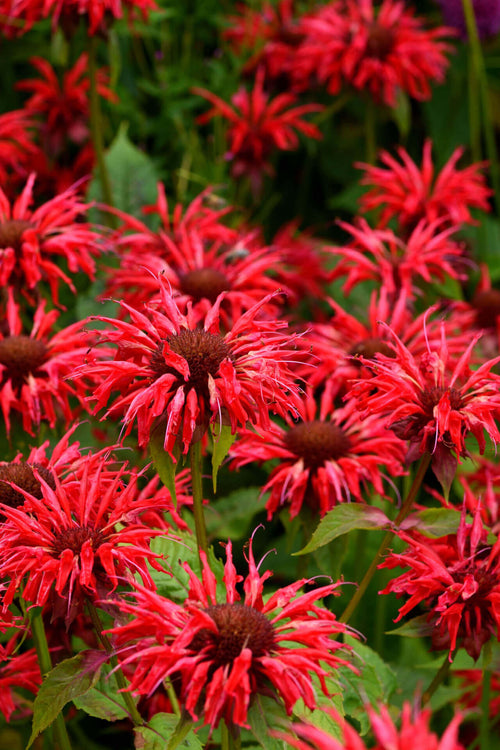Nurturing Pollinators through Bee Balm, Native Flowers, Dandelions, and Goldenrod.
The importance of bee-friendly landscapes cannot be overstated in a world where the decline of pollinator populations is a growing concern. Bees, in particular, play a vital role in pollinating a wide range of crops and plants, contributing to biodiversity, food security, and the overall health of ecosystems. Designing landscapes that cater to the needs of these essential insects not only benefits the environment but also adds beauty and vibrancy to our surroundings. Among the many plant species that can be incorporated into such landscapes, bee balm, native flowers, dandelions, and goldenrods are excellent choices.
Bee Balm
Bee balm (Monarda spp.), bergamot, or Oswego tea, is a captivating and aromatic perennial plant native to North America. With its vibrant, tubular flowers in red, pink, and purple shades, bee balm is a favorite among gardeners and pollinators. Its sweet, nectar-rich blossoms are a magnet for various bee species, butterflies, and hummingbirds. Not only does bee balm provide sustenance for pollinators, but it also offers several benefits to human observers. The aromatic leaves of bee balm can be used to make herbal teas, and its vibrant colors will add to any landscape. Bee balm is relatively easy to cultivate, preferring well-drained soil and a sunny location. By incorporating bee balm into your landscape, you create a haven that supports pollinators while enhancing the sensory experience of your outdoor space.
Native Flowers
When selecting flowers for a bee-friendly landscape, native species should take precedence. Native plants have evolved alongside local pollinators and are well-suited to their needs, providing ample pollen and nectar sources. Unlike some non-native ornamental plants, native flowers often require less water and maintenance, making them sustainable choices for eco-conscious gardeners. Species like aster, coneflower, and lupine are prime examples of native flowers that attract pollinators. These flowers offer sustenance and create essential habitat and nesting sites for bees. As a result, integrating native flowers into your landscape fosters a balanced ecosystem that supports pollinators and other wildlife.
Dandelions
Dandelions (Taraxacum officinale) have long been perceived as unwanted weeds in manicured lawns, leading to their removal through chemical means. However, these hardy yellow flowers are often among the food sources for bees in early spring. Dandelions are rich in nectar and pollen, providing vital nourishment when other flowering plants are scarce. Embracing dandelions in your bee-friendly landscape can have positive ripple effects. Allowing these plants to thrive in your yard offers bees sustenance and reduces the need for harmful pesticides and herbicides. Rather than viewing dandelions as nuisances, recognizing their role in supporting pollinators can reshape our relationship with these resilient plants.
Goldenrod
As summer transitions into fall, many flowers fade, leaving pollinators with limited foraging options. This is where goldenrod (Solidago spp.) shines. With its bright yellow plumes of tiny flowers, goldenrod becomes a crucial source of sustenance for bees and butterflies during late summer and early autumn. Goldenrod is often wrongly blamed for causing allergies when, in fact, it is the wind-pollinated ragweed that is the true culprit. Incorporating goldenrod into your landscape nourishes pollinators and dispels misconceptions about this vibrant plant.
Cultivating a Pollinator Paradise
Creating a bee-friendly landscape goes beyond individual plant choices; it involves careful planning and consideration of the overall ecosystem. Here are some additional tips to help you cultivate a thriving pollinator paradise:
Diversity Matters: Aim for various flowering plants that bloom throughout the growing season, ensuring a continuous food supply for pollinators.
Avoid Chemicals: Minimize or eliminate the use of pesticides and herbicides, as these can harm pollinators and disrupt the natural balance of your landscape.
Provide Shelter: Incorporate shrubs, trees, and other native vegetation that offer shelter, nesting sites, and protection from predators.
Water Sources: Include shallow water sources like birdbaths or small ponds to provide pollinators with a place to drink and cool off.
Educate and Share: Spread awareness about the importance of pollinators and encourage your community to join the effort in creating bee-friendly landscapes. In conclusion, bee-friendly landscapes hold the key to sustaining pollinator populations and preserving the delicate balance of our ecosystems. By selecting plants like bee balm, native flowers, dandelions, and goldenrods, you nourish these essential insects and contribute to the beauty and resilience of the natural world. As we embrace the role of stewards of our environment, creating bee-friendly landscapes is a powerful and meaningful step forward.



















































